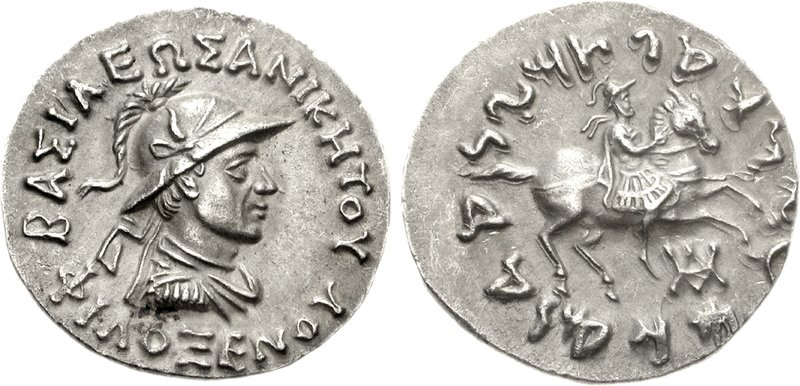Philoxenus Anicetus on:
[Wikipedia]
[Google]
[Amazon]
 Philoxenus Anicetus (
Philoxenus Anicetus (
 One overstrike is known, of Epander over Philoxenus.
One overstrike is known, of Epander over Philoxenus.
File:PhyloxenusCoin1.JPG, Philoxenus on horse.
File:Philoxenus Indo Greek square coin.jpg, Philoxenus coin in the Indian square standard.
Coins of Philoxenus
Ancient history of Pakistan Indo-Greek kings 1st-century BC rulers in Asia {{AncientGreece-bio-stub
 Philoxenus Anicetus (
Philoxenus Anicetus (Greek
Greek may refer to:
Greece
Anything of, from, or related to Greece, a country in Southern Europe:
*Greeks, an ethnic group.
*Greek language, a branch of the Indo-European language family.
**Proto-Greek language, the assumed last common ancestor ...
: ; epithet means "the Invincible") was an Indo-Greek
The Indo-Greek Kingdom, or Graeco-Indian Kingdom, also known historically as the Yavana Kingdom (Yavanarajya), was a Hellenistic-era Greek kingdom covering various parts of Afghanistan and the northwestern regions of the Indian subcontinent ( ...
king who ruled in the region spanning the Paropamisade to Punjab
Punjab (; Punjabi: پنجاب ; ਪੰਜਾਬ ; ; also romanised as ''Panjāb'' or ''Panj-Āb'') is a geopolitical, cultural, and historical region in South Asia, specifically in the northern part of the Indian subcontinent, comprising a ...
. Philoxenus seems to have been quite an important king who might briefly have ruled most of the Indo-Greek territory. Bopearachchi dates Philoxenus to c. 100–95 BCE and R. C. Senior to c. 125–110 BCE.
Historians have not yet connected Philoxenus with any dynasty, but he could have been the father of the princess Kalliope, who was married to the king Hermaeus
Hermaeus Soter or Hermaios Soter ( grc, Ἑρμαῖος ὁ Σωτήρ; epithet means "the Saviour") was a Western Indo-Greek king of the Eucratid Dynasty, who ruled the territory of Paropamisade in the Hindu-Kush region, with his capital in ...
.
Coins of Philoxenos
Philoxenus struck several series of bilingual Indian silver coins, with areverse
Reverse or reversing may refer to:
Arts and media
* ''Reverse'' (Eldritch album), 2001
* ''Reverse'' (2009 film), a Polish comedy-drama film
* ''Reverse'' (2019 film), an Iranian crime-drama film
* ''Reverse'' (Morandi album), 2005
* ''Reverse'' ...
of a mounted king, a type previously used as obverse by Antimachus II
Antimachus II Nikephoros ( Greek: ; the epithet means "the Victorious") was an Indo-Greek king. He ruled a vast territory from the Hindu-Kush to the Punjab around 170 BCE. He was almost certainly the eponymous son of Antimachus I, who is known ...
sixty years earlier and as reverse on rare types of Nicias
Nicias (; Νικίας ''Nikias''; c. 470–413 BC) was an Athenian politician and general during the period of the Peloponnesian War. Nicias was a member of the Athenian aristocracy and had inherited a large fortune from his father, which was inve ...
. Whether the horseman was a dynastic emblem or a portrait of the king as a cavalryman is unclear. Several Saka
The Saka ( Old Persian: ; Kharoṣṭhī: ; Ancient Egyptian: , ; , old , mod. , ), Shaka (Sanskrit ( Brāhmī): , , ; Sanskrit (Devanāgarī): , ), or Sacae (Ancient Greek: ; Latin: ) were a group of nomadic Iranian peoples who hist ...
kings used similar horsemen on their coinage.
His drachms were square, another feature that was rare among Indo-Greeks but standard for Sakas, and this indicates that Philoxenus had connections with the nomads that had conquered Bactria.
Philoxenus struck bronzes with female deity/bull, or Helios/Nike
Nike often refers to:
* Nike (mythology), a Greek goddess who personifies victory
* Nike, Inc., a major American producer of athletic shoes, apparel, and sports equipment
Nike may also refer to:
People
* Nike (name), a surname and feminine give ...
.
Philoxenus also minted some Attic-type tetradrachms (with Greek legend only), meant for circulation in Bactria.
Overstrikes
 One overstrike is known, of Epander over Philoxenus.
One overstrike is known, of Epander over Philoxenus.
Other coins
Japan Currency Museum
__NOTOC__
The , formally known as the is a museum about Japanese currency located in front of the Bank of Japan building in Chūō, Tokyo.
The museum opened in November 1985.Edan CorkillBank of Japan Currency Museum invests in exhibition on wa ...
.
File:Whitehead Coins of the Punjab Museum Plate VII Phyloxenos.jpg, Coin of Phyloxenos.
See also
* Greco-Bactrian Kingdom * Seleucid Empire *Greco-Buddhism
Greco-Buddhism, or Graeco-Buddhism, is the cultural syncretism between Hellenistic culture and Buddhism, which developed between the fourth century BC and the fifth century AD in Gandhara, in present-day north-western Pakistan and parts of nort ...
* Indo-Scythians
Indo-Scythians (also called Indo-Sakas) were a group of nomadic Iranian peoples of Scythian origin who migrated from Central Asia southward into modern day Pakistan and Northwestern India from the middle of the 2nd century BCE to the 4th centu ...
* Indo-Parthian Kingdom
The Indo-Parthian Kingdom was a Parthian kingdom founded by Gondophares, and active from 19 CE to c. 226 CE. At their zenith, they ruled an area covering parts of eastern Iran, various parts of Afghanistan and the northwest regions of the Indian s ...
* Kushan Empire
References
* ''The Greeks in Bactria and India'', W. W. Tarn, Cambridge University Press.External links
Coins of Philoxenus
Ancient history of Pakistan Indo-Greek kings 1st-century BC rulers in Asia {{AncientGreece-bio-stub